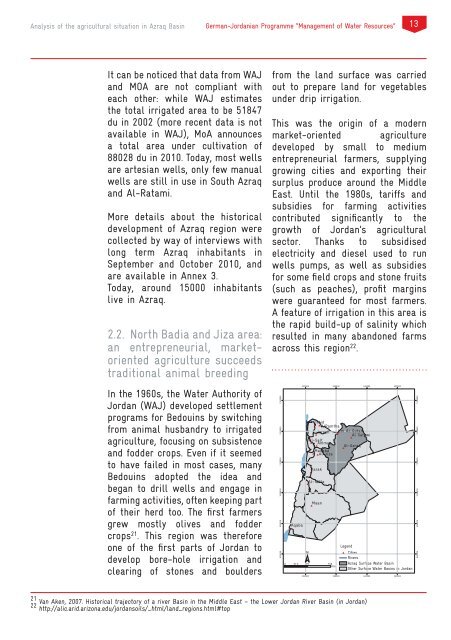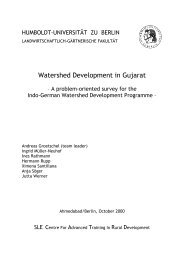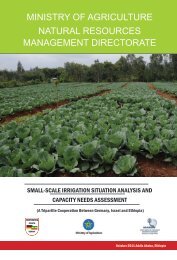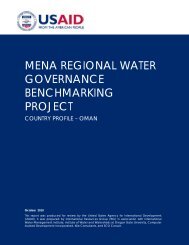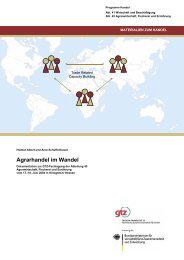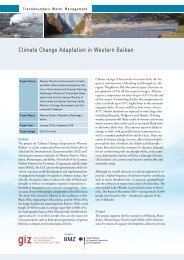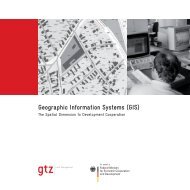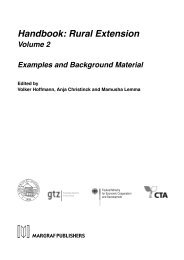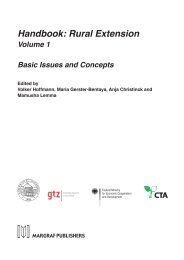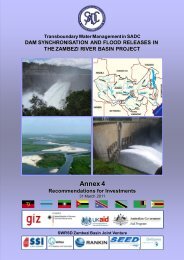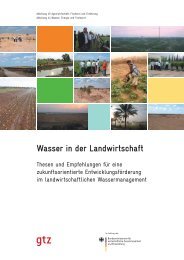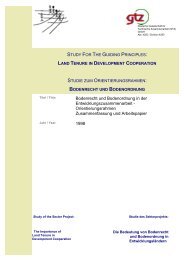Farming in the - WordPress.com
Farming in the - WordPress.com
Farming in the - WordPress.com
You also want an ePaper? Increase the reach of your titles
YUMPU automatically turns print PDFs into web optimized ePapers that Google loves.
Analysis of <strong>the</strong> agricultural situation <strong>in</strong> Azraq Bas<strong>in</strong><br />
German-Jordanian Programme “Management of Water Resources”<br />
13<br />
It can be noticed that data from WAJ<br />
and MOA are not <strong>com</strong>pliant with<br />
each o<strong>the</strong>r: while WAJ estimates<br />
<strong>the</strong> total irrigated area to be 51847<br />
du <strong>in</strong> 2002 (more recent data is not<br />
available <strong>in</strong> WAJ), MoA announces<br />
a total area under cultivation of<br />
88028 du <strong>in</strong> 2010. Today, most wells<br />
are artesian wells, only few manual<br />
wells are still <strong>in</strong> use <strong>in</strong> South Azraq<br />
and Al-Ratami.<br />
More details about <strong>the</strong> historical<br />
development of Azraq region were<br />
collected by way of <strong>in</strong>terviews with<br />
long term Azraq <strong>in</strong>habitants <strong>in</strong><br />
September and October 2010, and<br />
are available <strong>in</strong> Annex 3.<br />
Today, around 15000 <strong>in</strong>habitants<br />
live <strong>in</strong> Azraq.<br />
2.2. North Badia and Jiza area:<br />
an entrepreneurial, marketoriented<br />
agriculture succeeds<br />
traditional animal breed<strong>in</strong>g<br />
In <strong>the</strong> 1960s, <strong>the</strong> Water Authority of<br />
Jordan (WAJ) developed settlement<br />
programs for Bedou<strong>in</strong>s by switch<strong>in</strong>g<br />
from animal husbandry to irrigated<br />
agriculture, focus<strong>in</strong>g on subsistence<br />
and fodder crops. Even if it seemed<br />
to have failed <strong>in</strong> most cases, many<br />
Bedou<strong>in</strong>s adopted <strong>the</strong> idea and<br />
began to drill wells and engage <strong>in</strong><br />
farm<strong>in</strong>g activities, often keep<strong>in</strong>g part<br />
of <strong>the</strong>ir herd too. The first farmers<br />
grew mostly olives and fodder<br />
crops 21 . This region was <strong>the</strong>refore<br />
one of <strong>the</strong> first parts of Jordan to<br />
develop bore-hole irrigation and<br />
clear<strong>in</strong>g of stones and boulders<br />
from <strong>the</strong> land surface was carried<br />
out to prepare land for vegetables<br />
under drip irrigation.<br />
This was <strong>the</strong> orig<strong>in</strong> of a modern<br />
market-oriented agriculture<br />
developed by small to medium<br />
entrepreneurial farmers, supply<strong>in</strong>g<br />
grow<strong>in</strong>g cities and export<strong>in</strong>g <strong>the</strong>ir<br />
surplus produce around <strong>the</strong> Middle<br />
East. Until <strong>the</strong> 1980s, tariffs and<br />
subsidies for farm<strong>in</strong>g activities<br />
contributed significantly to <strong>the</strong><br />
growth of Jordan’s agricultural<br />
sector. Thanks to subsidised<br />
electricity and diesel used to run<br />
wells pumps, as well as subsidies<br />
for some field crops and stone fruits<br />
(such as peaches), profit marg<strong>in</strong>s<br />
were guaranteed for most farmers.<br />
A feature of irrigation <strong>in</strong> this area is<br />
<strong>the</strong> rapid build-up of sal<strong>in</strong>ity which<br />
resulted <strong>in</strong> many abandoned farms<br />
across this region 22 .<br />
1000000 1100000 1200000 1300000<br />
800000 900000<br />
Aqaba<br />
200000 300000 400000 500000<br />
N<br />
0 37.5 75<br />
200000<br />
Irbid<br />
AlRamtha<br />
Jerash Um Al-Quta<strong>in</strong><br />
Al Safawi<br />
Al-Salt<br />
Amman<br />
Madaba<br />
Al-Jiza<br />
Karak<br />
Al-Tafila<br />
Maan<br />
150<br />
Km<br />
Al-Azraq<br />
Legend<br />
Cities<br />
Rivers<br />
Azraq Surface Water Bas<strong>in</strong><br />
O<strong>the</strong>r Surface Water Bas<strong>in</strong>s <strong>in</strong> Jordan<br />
300000 400000 500000<br />
800000 900000 1000000 1100000 1200000 1300000<br />
21 Van Aken, 2007. Historical trajectory of a river Bas<strong>in</strong> <strong>in</strong> <strong>the</strong> Middle East – <strong>the</strong> Lower Jordan River Bas<strong>in</strong> (<strong>in</strong> Jordan)<br />
22 http://alic.arid.arizona.edu/jordansoils/_html/land_regions.html#top


